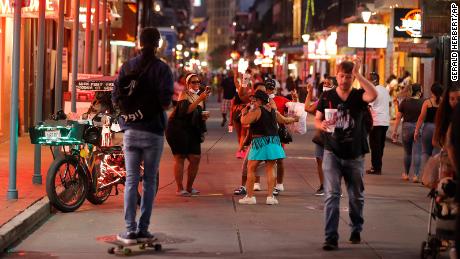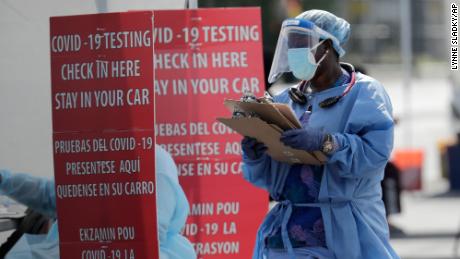Analysis: America shuts down again — choosing reality over Trump’s false claims
As emergency rooms filled and the virus quickened its relentless march across southern and Western states, Trump stuck to the fiction that the worst is already over: “We had to close it down; now we’re opening it up,” the President said of the economy at the White House, patting himself on the back for saving “millions of lives.”
As new cases of the disease reach 60,000 a day nationwide, many leaders, including those who supported Trump’s aggressive approach, now have little choice but to prioritize science over politics, leaving the President looking out of touch with reality.
In Texas, Houston’s Democratic Mayor Sylvester Turner proposed a two-week shutdown, days after Republican Gov. Greg Abbott raised the possibility of more stringent measures after issuing a mask wearing mandate that offended conservative orthodoxy. West Virginia called time’s up in bars in the worst-hit county.
Florida, which on Saturday set the record for any state in single day data on new infections, now has more Covid-19 cases than all but eight entire countries.
The picture is of a nation that is beginning to shut down again in defiance of the President’s triumphant but misleading claims that a “transition to greatness” is under way. Restrictions imposed on cities as large as Houston and Los Angeles could set back the surprising revival in the economy last month.
Modest job gains, trumpeted by the President, could turn into permanent job losses.
“It is very clear — and we know this from countries throughout the world — that if you physically separate people, to the point of not allowing the virus to transmit … we know that we can do that if we shut down,” Fauci said on a Stanford School of Medicine webinar.
“We did not shut down entirely — and that’s the reason why, when we went up, we started to come down, and then we plateaued at a level that was really quite high — about 20,000 infections a day,” Fauci said. “Then, as we started to reopen, we’re seeing the surges that we’re seeing today, as we speak, in California … in Arizona, in Texas, in Florida, and in several other states.”
New York and Massachusetts have hard lessons
There are a few bright spots. For the first time in months, there were no Covid-19 deaths in New York City in a 24-hour period, a moment of deliverance that Democratic Mayor Bill de Blasio called “striking and moving.” Massachusetts announced that its seven-day average of positive tests had fallen to 1.7% — down 94% since mid-April.
The lesson for the states now in the center of the storm — that jumped ahead of the US Centers for Disease Control and Prevention guidelines on safe reopening — are sobering. New York and Massachusetts bought what may still be only a temporary truce with the coronavirus by weeks of lockdowns and a strict reopening process that waited for the curve of infections to be properly suppressed before restrictions were lifted. Even now, there’s no guarantee the virus won’t return at dangerous levels when normal life picks up.
None of this seems to have filtered through to Trump. As always, the President was fixated on what latest developments meant for him — especially as he rammed home his demand for all children to get back to school despite having no plan for how to make their return safe.
In a fresh sign of self-absorption on Monday, he turned perhaps the most acute current social complication of the pandemic into a charge that his political enemies wanted to keep kids stuck at home to hurt him.
“I think they think they’ll do better if they can keep the schools closed in the election. I don’t think it’s going to help them, frankly, but I think they feel that by keeping schools closed, that’s a bad thing for the country and, therefore, that’s a good thing for them,” Trump said.
What really matters for Trump
The President did something similar earlier in the day, when he highlighted a tweet by Chuck Woolery, the ex-host of dating show “Love Connection” who warned “everyone is lying” about the seriousness of the current crisis, just to “keep the “economy from coming back, which is about the election.”
It’s not at all clear that most Americans stuck in an endless national nightmare are most concerned about an election — especially one that’s faded into the background and is still more than three months away. Parents want to know if their kids can begin learning again. The unemployed want their jobs back. The country wants its pre-virus life back.
Trump’s obsession with his own political prospects has been the driving force of his administration and is a recurrent theme. His domestic agenda is almost solely designed to reward his most loyal and radical voters and his foreign policy is geared to creating splashy photo ops with the President in the starring role.
The reopening of schools is crucial to the return of the economy and to the impression that America has bounced back to normal life that Trump is trying to reshape into an election message of a “transition to greatness.” Until kids are in school full-time, many parents with child care issues cannot return to work, depriving America’s economic engine of its full capacity.
But characteristically, Trump is ignoring complicated questions — such as how to ensure that a mass return to school doesn’t supercharge the pandemic — as he considers what’s best for himself.
![]()






